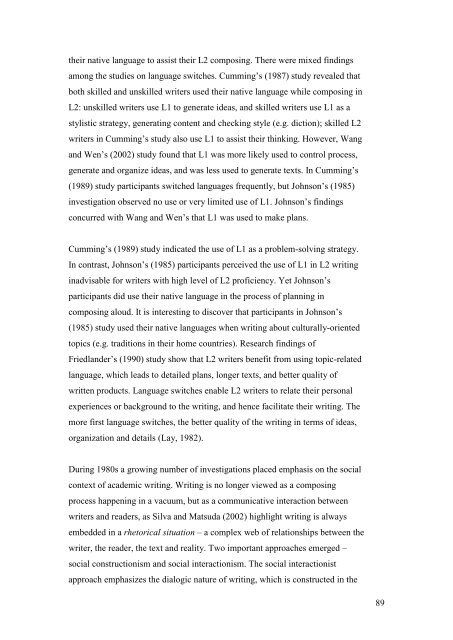The challenge of academic writing for Chinese students within ...
The challenge of academic writing for Chinese students within ...
The challenge of academic writing for Chinese students within ...
You also want an ePaper? Increase the reach of your titles
YUMPU automatically turns print PDFs into web optimized ePapers that Google loves.
their native language to assist their L2 composing. <strong>The</strong>re were mixed findings<br />
among the studies on language switches. Cumming‘s (1987) study revealed that<br />
both skilled and unskilled writers used their native language while composing in<br />
L2: unskilled writers use L1 to generate ideas, and skilled writers use L1 as a<br />
stylistic strategy, generating content and checking style (e.g. diction); skilled L2<br />
writers in Cumming‘s study also use L1 to assist their thinking. However, Wang<br />
and Wen‘s (2002) study found that L1 was more likely used to control process,<br />
generate and organize ideas, and was less used to generate texts. In Cumming‘s<br />
(1989) study participants switched languages frequently, but Johnson‘s (1985)<br />
investigation observed no use or very limited use <strong>of</strong> L1. Johnson‘s findings<br />
concurred with Wang and Wen‘s that L1 was used to make plans.<br />
Cumming‘s (1989) study indicated the use <strong>of</strong> L1 as a problem-solving strategy.<br />
In contrast, Johnson‘s (1985) participants perceived the use <strong>of</strong> L1 in L2 <strong>writing</strong><br />
inadvisable <strong>for</strong> writers with high level <strong>of</strong> L2 pr<strong>of</strong>iciency. Yet Johnson‘s<br />
participants did use their native language in the process <strong>of</strong> planning in<br />
composing aloud. It is interesting to discover that participants in Johnson‘s<br />
(1985) study used their native languages when <strong>writing</strong> about culturally-oriented<br />
topics (e.g. traditions in their home countries). Research findings <strong>of</strong><br />
Friedlander‘s (1990) study show that L2 writers benefit from using topic-related<br />
language, which leads to detailed plans, longer texts, and better quality <strong>of</strong><br />
written products. Language switches enable L2 writers to relate their personal<br />
experiences or background to the <strong>writing</strong>, and hence facilitate their <strong>writing</strong>. <strong>The</strong><br />
more first language switches, the better quality <strong>of</strong> the <strong>writing</strong> in terms <strong>of</strong> ideas,<br />
organization and details (Lay, 1982).<br />
During 1980s a growing number <strong>of</strong> investigations placed emphasis on the social<br />
context <strong>of</strong> <strong>academic</strong> <strong>writing</strong>. Writing is no longer viewed as a composing<br />
process happening in a vacuum, but as a communicative interaction between<br />
writers and readers, as Silva and Matsuda (2002) highlight <strong>writing</strong> is always<br />
embedded in a rhetorical situation – a complex web <strong>of</strong> relationships between the<br />
writer, the reader, the text and reality. Two important approaches emerged –<br />
social constructionism and social interactionism. <strong>The</strong> social interactionist<br />
approach emphasizes the dialogic nature <strong>of</strong> <strong>writing</strong>, which is constructed in the<br />
89


